How to buy a domain name for your website: a step-by-step guide
You'll need to buy a domain name before you build your website

A domain name is what people enter into a web browser in order to 'go to' a website. They’re a much faster and intuitive alternative than having to remember an entire IP address and have become one of the most crucial branding elements of a site.
When you start a business, one of the first things you need to do is create a website. Part of that is coming up with a brand name that can be used as a domain name.
Domain names typically consist of their name, separated by a dot from the TLD (Top-level domain), such as .com or .xyz. Your choice of both of these elements will significantly impact how easily visitors can find, remember, and recommend your website to others.
There are currently over 364 million registered domains worldwide (that's gown by 16 million since I last updated this page). This makes finding and buying the perfect domain name pretty challenging because you desired domain name could have already been purchased by someone else. What’s more, not every domain registrar offers the same prices and conditions.
If you’re planning to purchase a domain for your site, this article is for you. We’ll show you how to buy a domain name from various registrars and web hosting providers, as well as showcase some domain name registration tips to keep in mind.
How to buy a domain name in five steps
While the process of buying a domain name is relatively simple, it shouldn’t be taken lightly.
When put together properly, a domain should be catchy, give the target audience an idea of what the website offers, and entice them to visit it.
Sign up to the TechRadar Pro newsletter to get all the top news, opinion, features and guidance your business needs to succeed!
Follow these steps to buy a domain name:
- Determine the purpose of the website. From there, brainstorm a list of potential domain names that are relevant and ideally include a keyword of your website’s niche.
- Pick a brandable name. From the list, select a domain name that sounds concise, memorable, and easy to spell and pronounce. It should be catchy enough that users can share it easily with others. Avoid long, complicated names and symbols.
- Check the domain name’s availability. Use a checker tool to see if it’s on sale and which TLDs or domain extensions are available. The most popular TLD is .com, as most users are familiar with it.
- Choose one of the best domain registrars or best web hosting providers to buy the domain from. For the best domain registrar, we recommend Namecheap.com because it's a versatile provider that provides excellent value for money. If you choose to go down the web hosting provider route, we recommend Hostinger because it offers you a domain for free and they're the best web host overall based on our experience. Make sure it offers basic features like DNS management and email forwarding. Also, compare the pricing, renewal rates, add-ons, and support to see which one offers the best value for money.
- Register the domain name. Complete the payment and domain registration process. A domain name can be available for use between one to ten years, depending on your preferences. Finally, remember to check your email to verify the domain ownership.
After finalizing the domain purchase, start building your website. If you buy a domain name and web hosting plan from separate vendors, make sure to point the domain to your hosting account so that visitors can open your website correctly.
Now that you’re familiar with the general steps, we’ll explain how to buy a domain name from top domain registrar and web hosting service providers.
How to register a domain name with Hostinger
Known for its fast and user-friendly web hosting, Hostinger also provides affordable domain registration services. This European company has .com domains starting from $9.99/year, which is one of the lowest prices offered on the market.
Hostinger offers alternative TLDs such as .online, .xyz, .tech, and .store, so there are more options to experiment with if the .com domain names are unavailable.
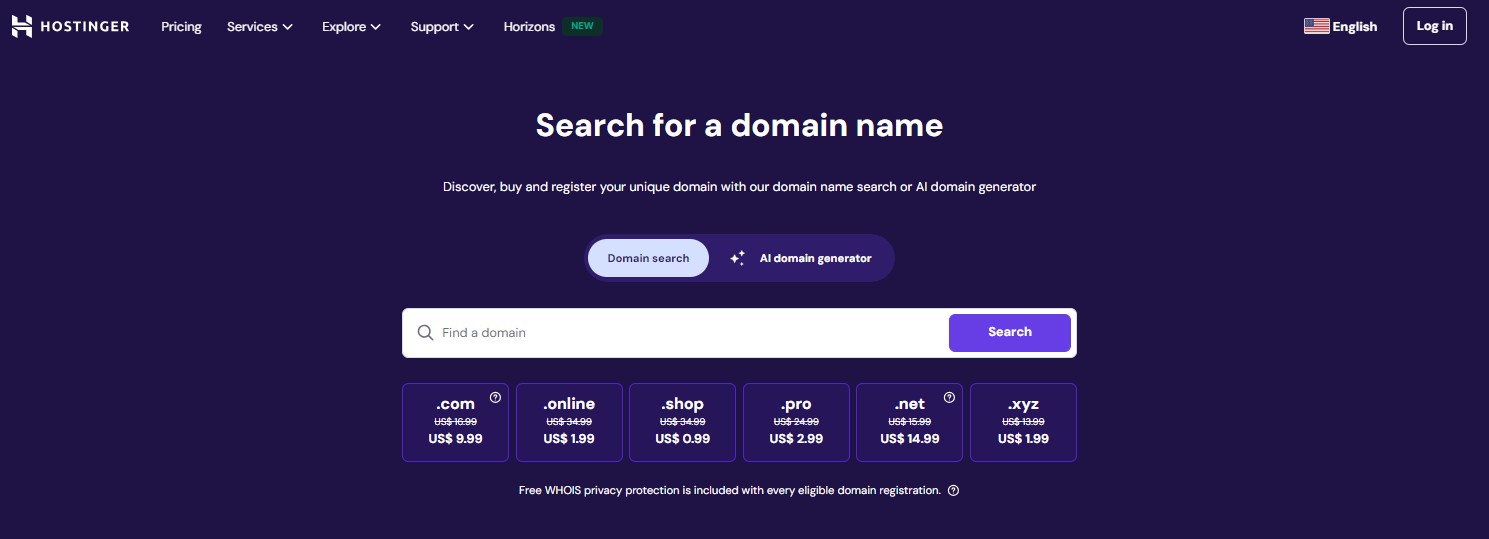
To buy a domain name with Hostinger, navigate to their domain checker page. Then enter your desired name on the field and press Search.
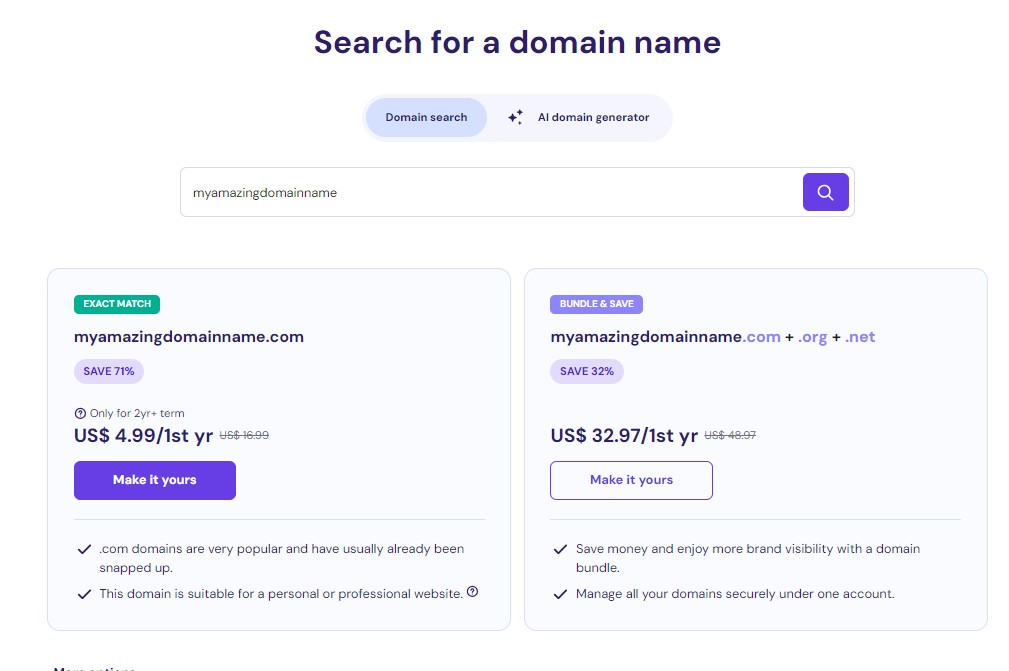
Click Make it Yours and you'll be directed to the cart where you can choose the duration of the domain and add additional purchases like email or hosting.
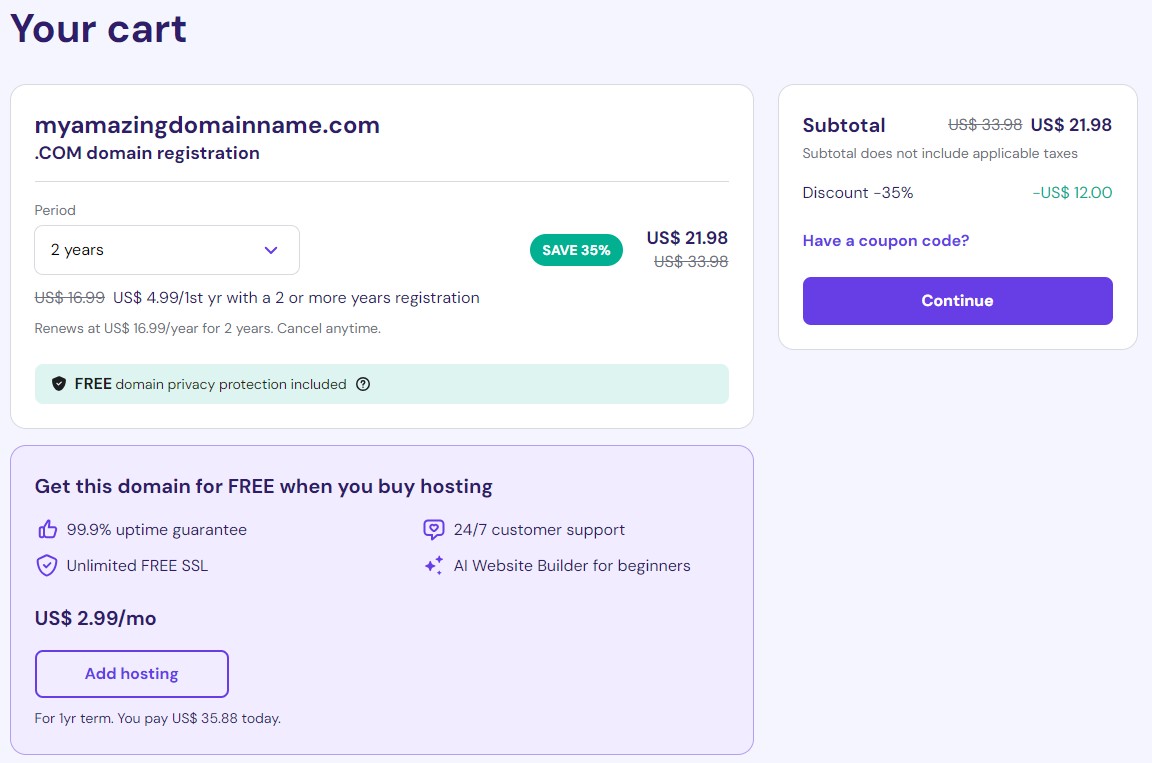
Press the Checkout Now button to finalize the payment and create a Hostinger account. Once that’s done, the system will redirect you to the domain control panel to complete the domain registration process.
The required contact details include your name, email address, physical address, and phone number. If the domain is for commercial purposes, insert the business name. Review the information and click Finish registration.
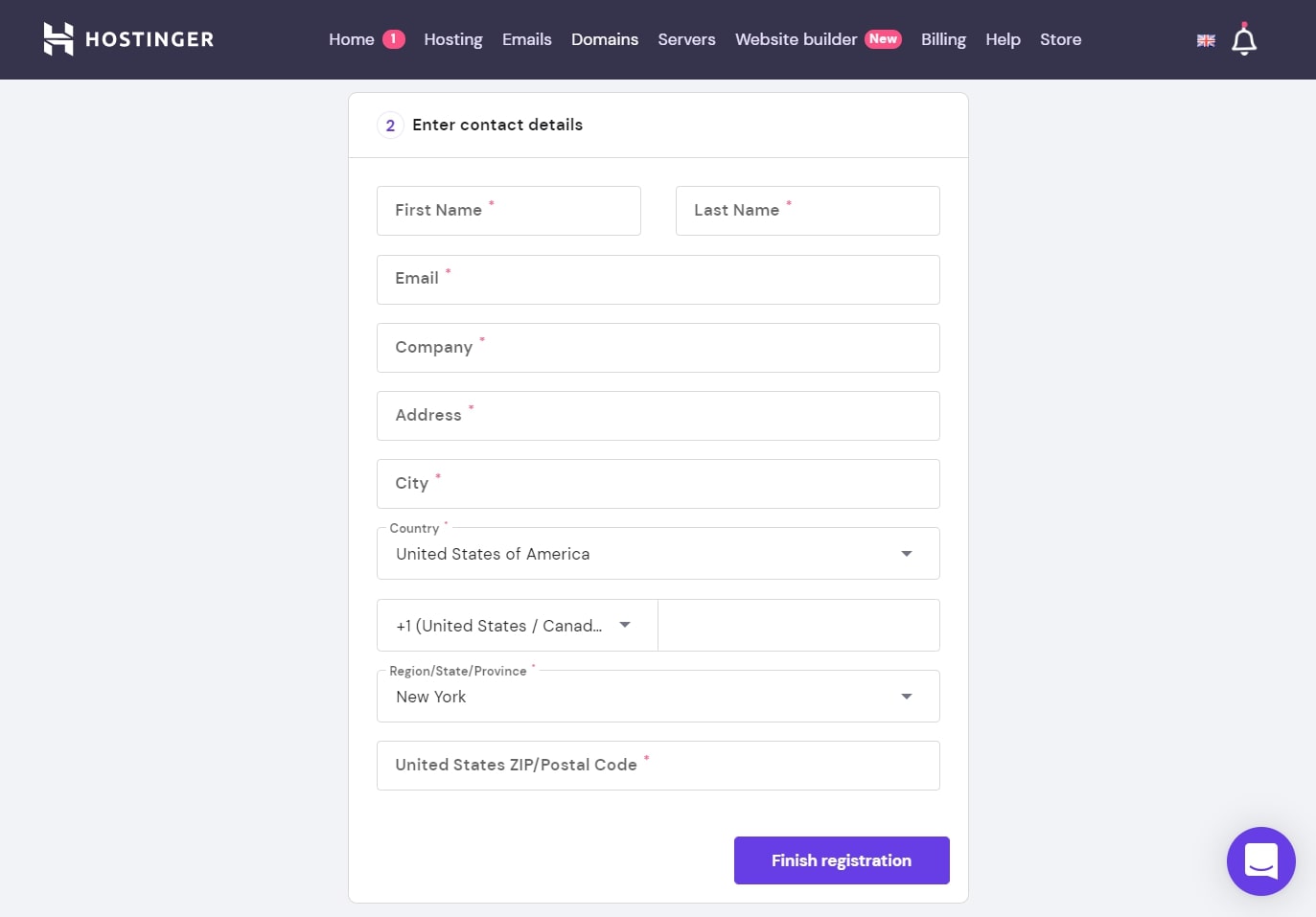
Once finished, Hostinger will send a message to your email address asking to verify the domain ownership through a link. The system will temporarily suspend the domain if it’s not validated within 15 days, so it’s best to complete this step immediately.
How to register a domain name with Bluehost
Bluehost is a web hosting company based in the United States. Like Hostinger, it also offers a domain registration service. It even includes a free domain name for one year in its most affordable subscription, which costs $1.99/month for the first year.
Besides the generic TLDs, this hosting company has a wide array of alternative extensions for various niches – such as .ink, .photo, and .guru. While they’re not as popular as .com, they can be an excellent touch to make your website stand out.
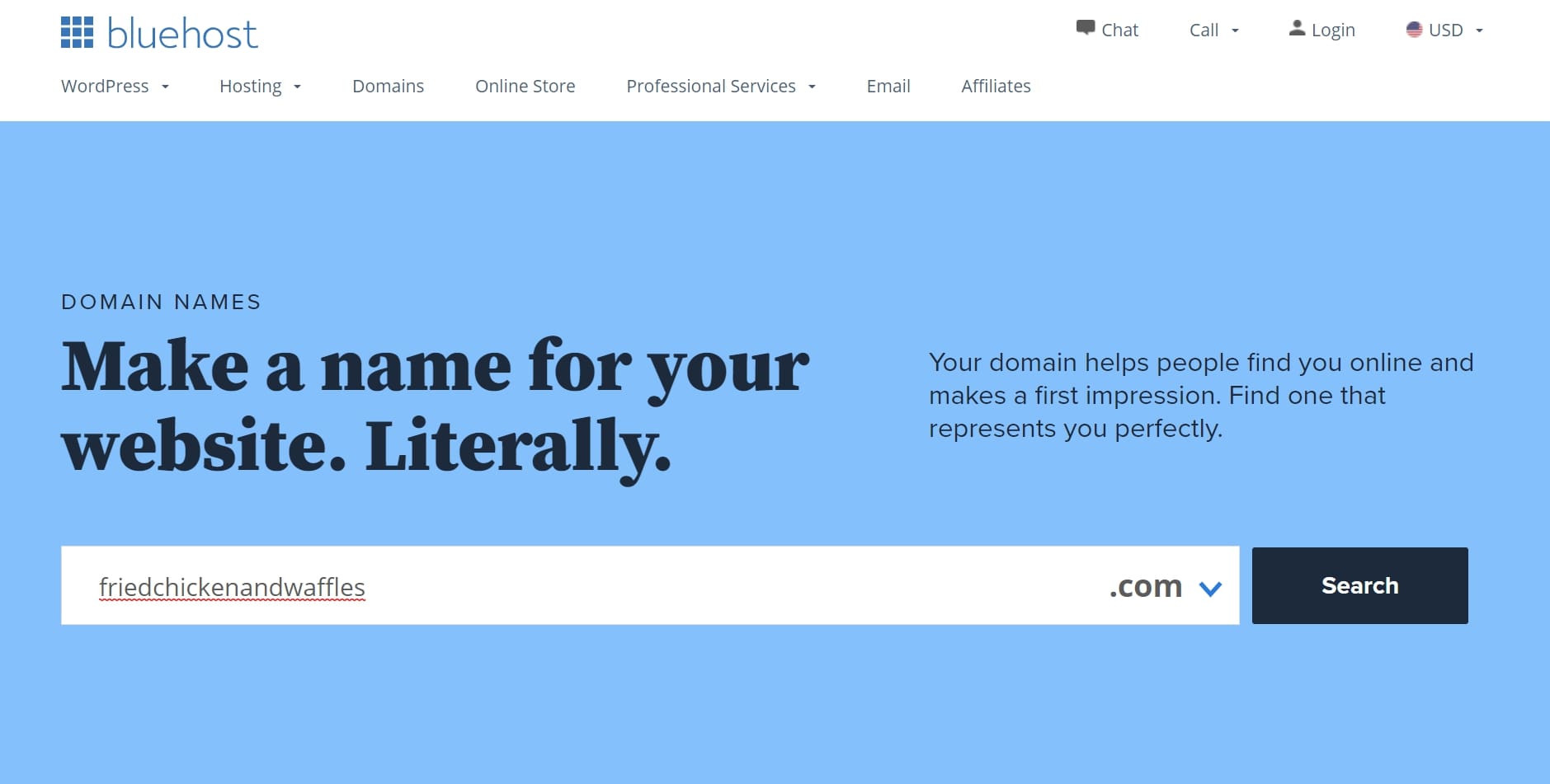
To get a domain name from Bluehost, open the Domains page on the site. Then insert a keyword paired with your desired domain name extension on the search bar.
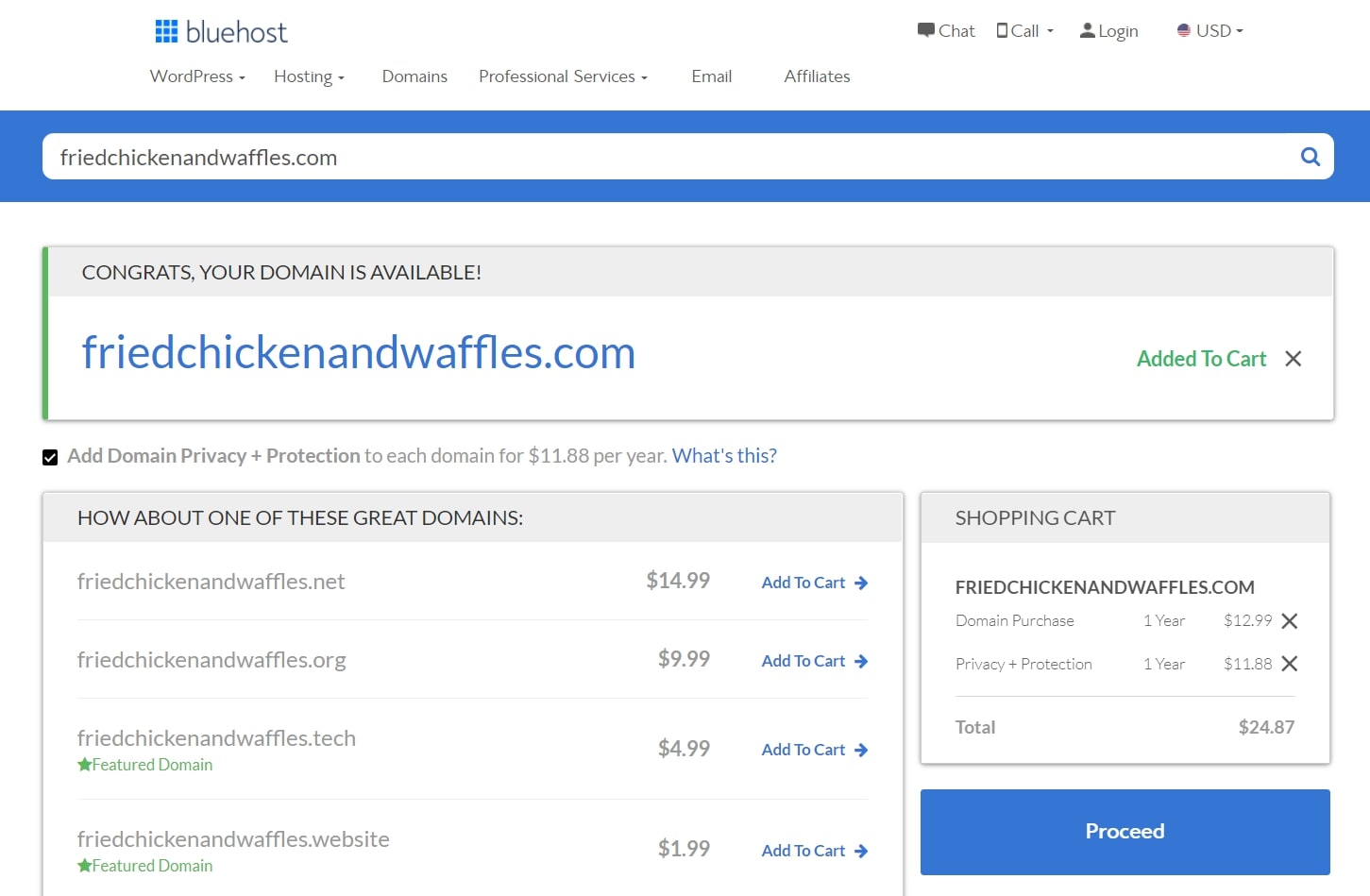
The page will reveal if the domain name is available. If not, choose one of the other options below.
A .com extension costs $12.99/year, which is the average price. On the other hand, the privacy and protection service is $11.88/year.
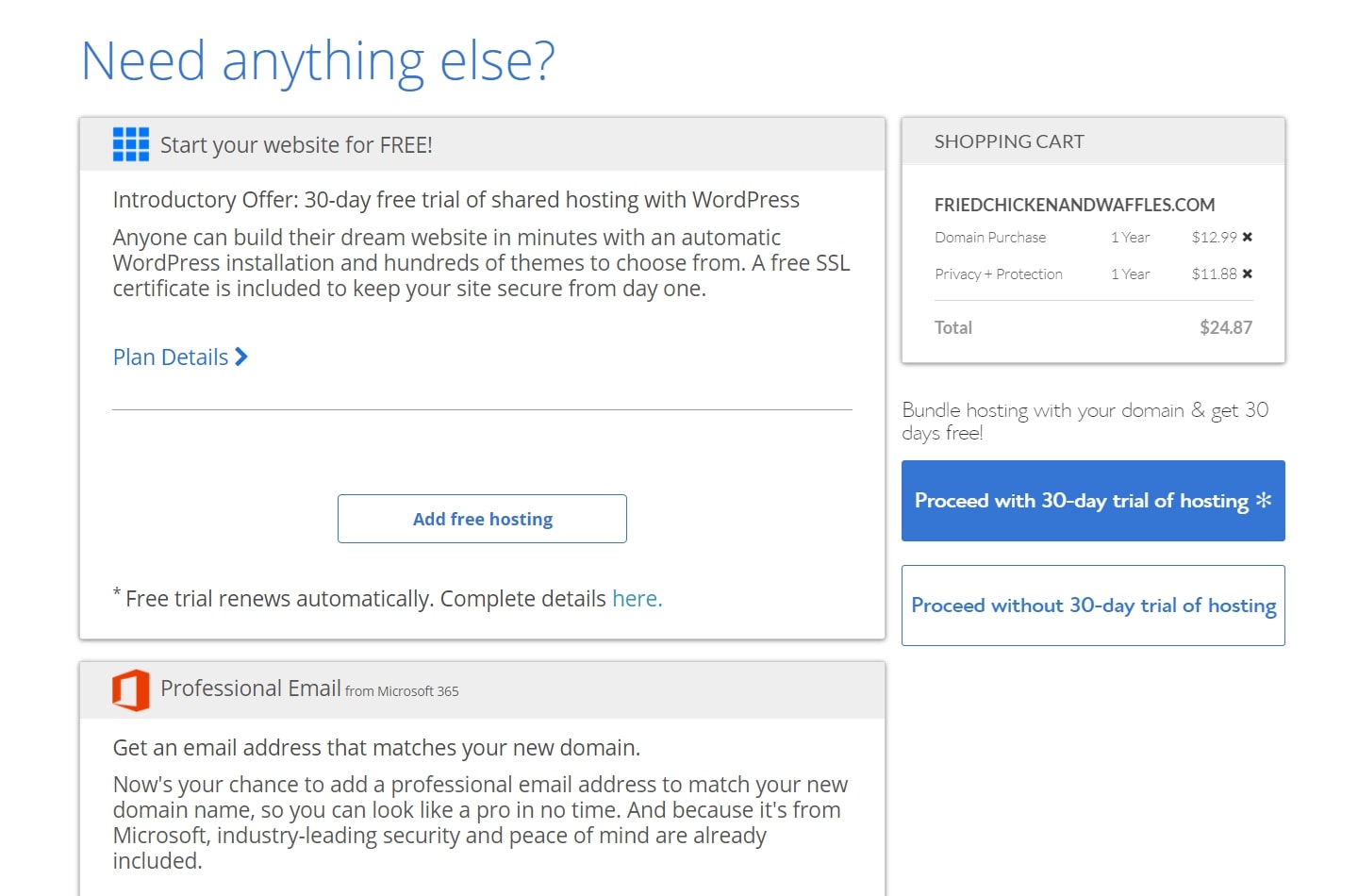
Click Proceed to start the checkout process. Bluehost will offer to bundle the domain name with a 30-day free trial for a shared web hosting service and a free SSL certificate. An email service plan with Microsoft 365 is also available, ranging between $2.99/month and $3.99/month.
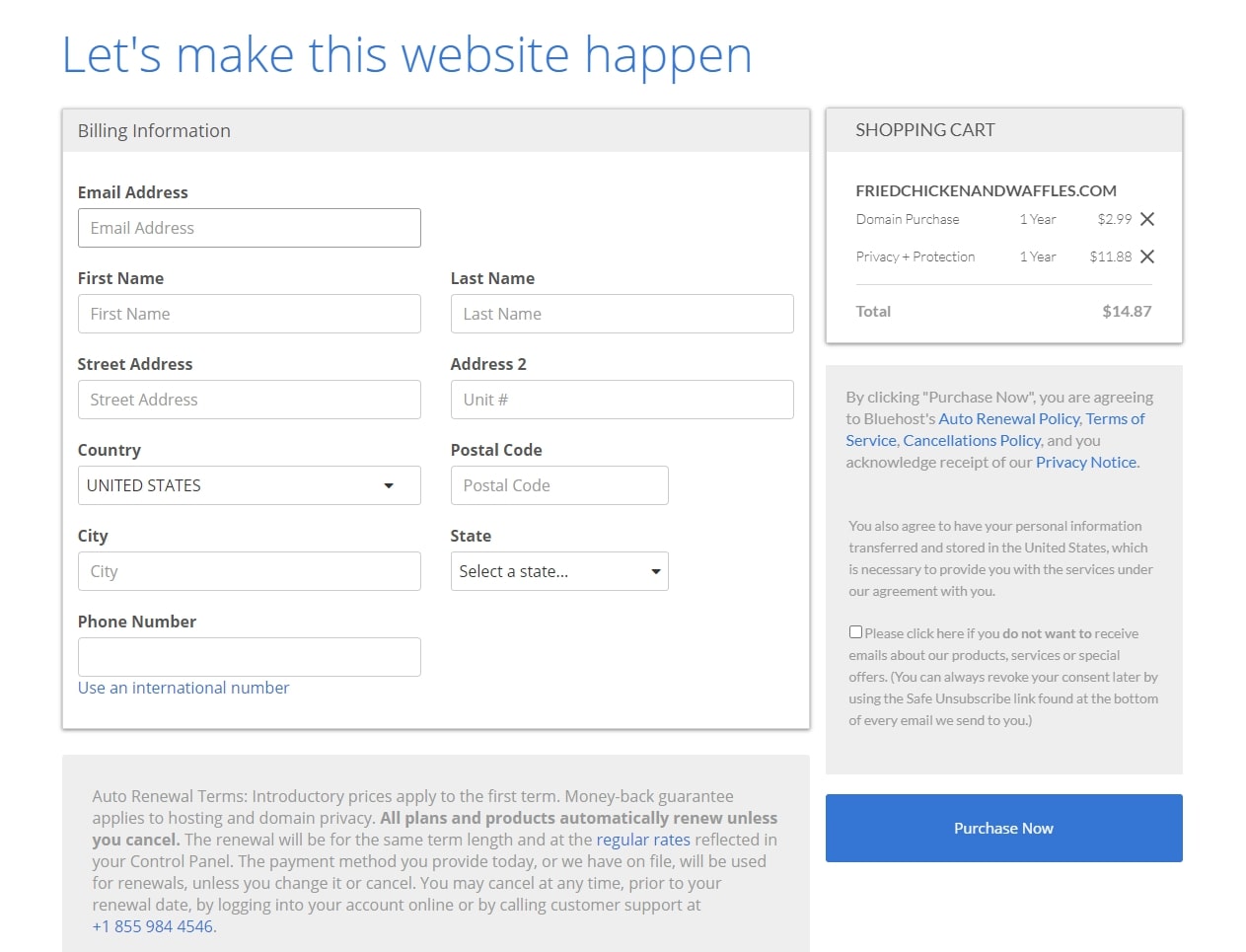
Press one of the Proceed buttons to complete the order. Fill in the billing information and choose a method to pay for the domain name registration fee.
Once done, Bluehost will send a verification email to your inbox to validate the domain ownership. Click on the link, and the domain name should now be usable.
Note that all Bluehost customers are subject to automatic renewals. However, it’s possible to change this setting within 16 days of the expiration date.
That said, we recommend enabling this feature anyway. If you forget to renew the terms, your website will be unavailable, and the domain can return for sale on the open market within a few weeks.
How to register a domain name with HostGator
Next, we’ll explain how to get a domain name on HostGator. Part of the same group as Bluehost, it offers a user-friendly drag-and-drop website builder and feature-rich web hosting services.
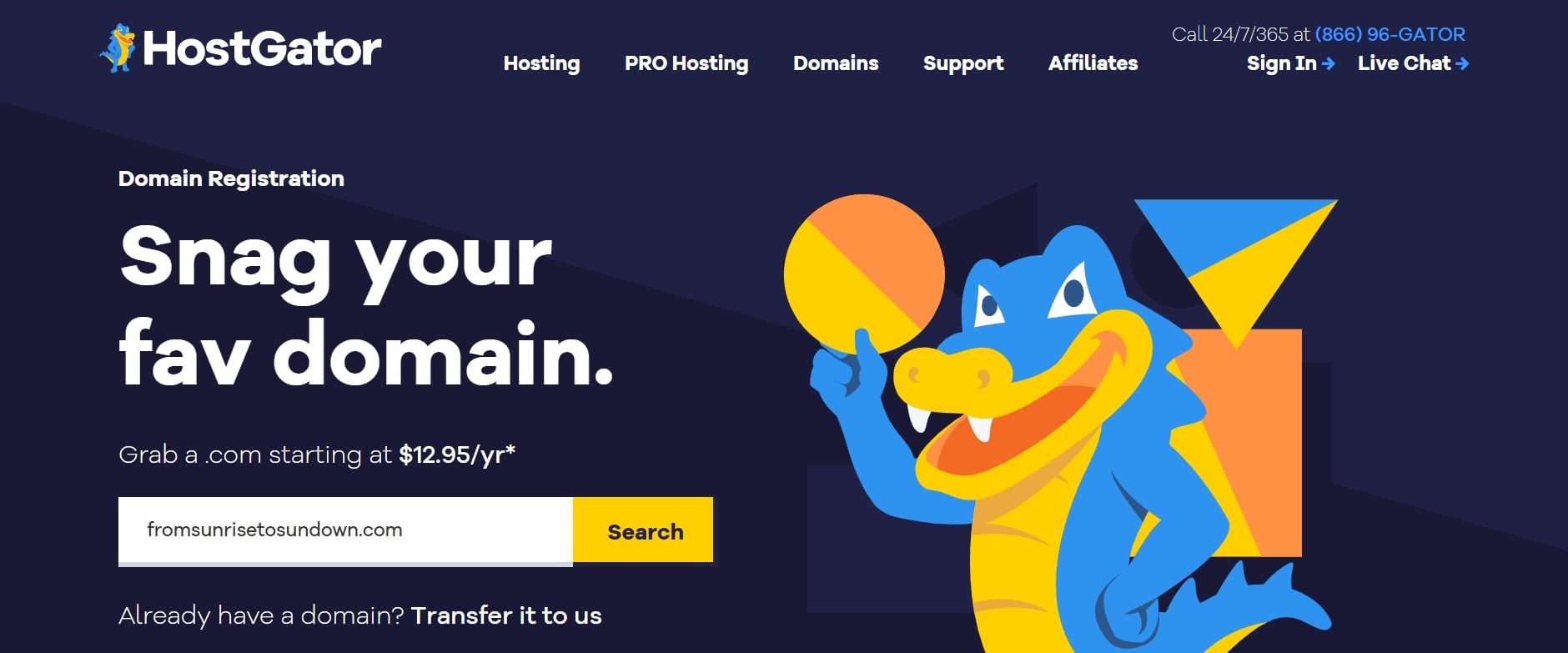
The first step to buying a domain name on HostGator is to open the Domains page on their website. Insert a domain name and on the search field and press the Enter key.
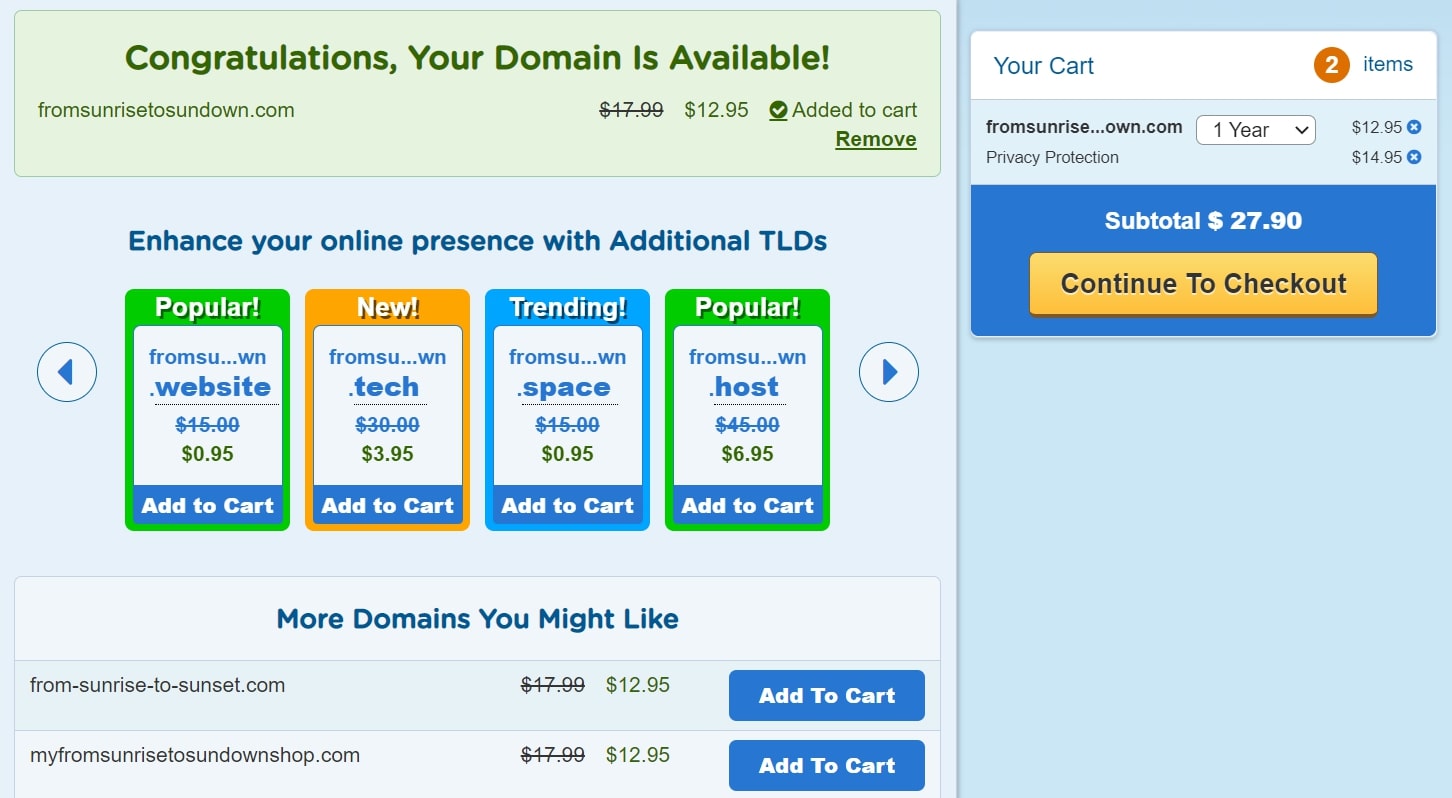
If the domain is unavailable, pick a recommended alternative with a different domain extension or name variation.
The cost for a .com domain at HostGator is similar to Bluehost, starting from $12.99/year. Bundling the item with a privacy and protection feature is also possible, costing $14.95/year. Pick between one, two, or a three-year registration period, then click Continue To Checkout.
Now, create a HostGator account and fill in your billing information. HostGator has two payment options – credit card and PayPal.
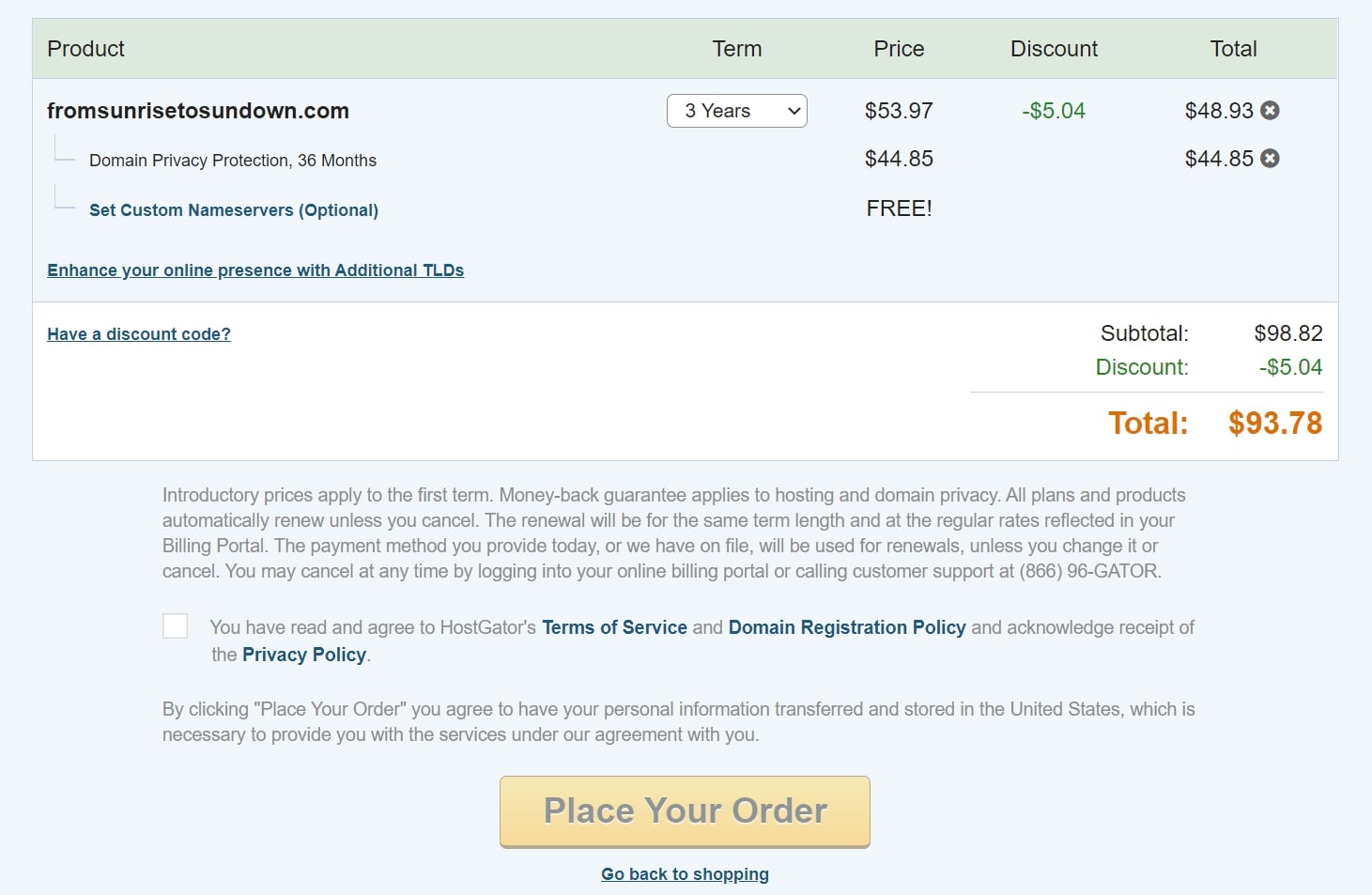
Before finalizing the purchase, HostGator will preview the order. Here, you can set custom nameservers to point the domain name to a third-party hosting account if desired. Click Place Your Order once everything looks right.
Finally, HostGator will send a domain ownership validation request to your registered email address. Remember to click on the link within 15 days to prevent the domain from temporary suspension.
Besides the steps above, HostGator also offers a domain name registration service via their support team. However, this alternative method is only applicable to certain TLDs.
How to register a domain name with Wix
Wix is one of the most widely-used website builders, having powered over 200 million users worldwide. While it allows creating a website for free, you will need a premium plan to connect a custom domain name.
The price for a .com domain name is $19.35/year. Note that Wix’s list of extensions is not as vast as other registrars, as it doesn’t support such TLDs as .io, .tech, or .live. However, more generic options are available.
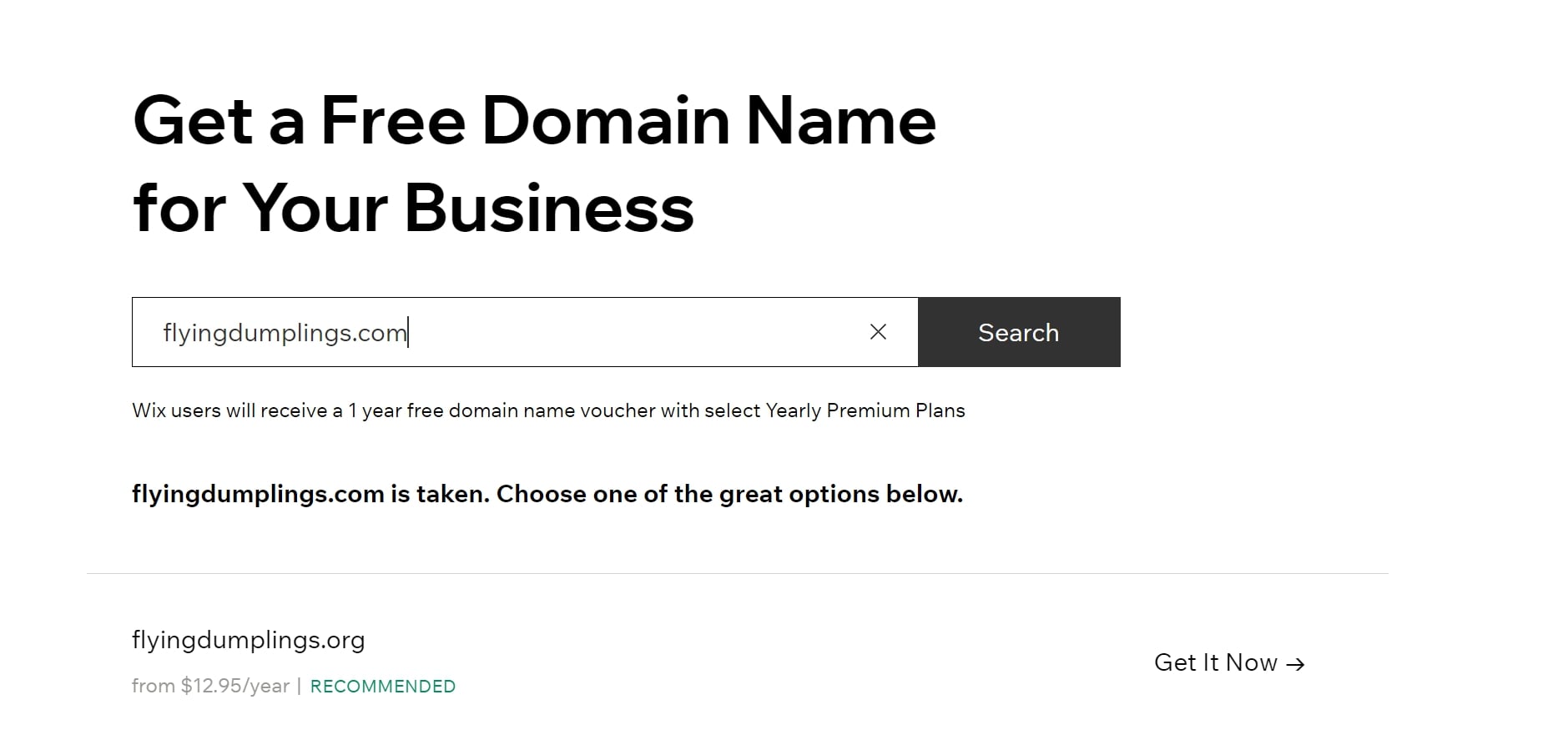
Navigate to Wix’s domains page to begin the domain name search. Then, enter a term using a domain extension and press Search. If someone else has taken the name, it will suggest other options with different TLDs.
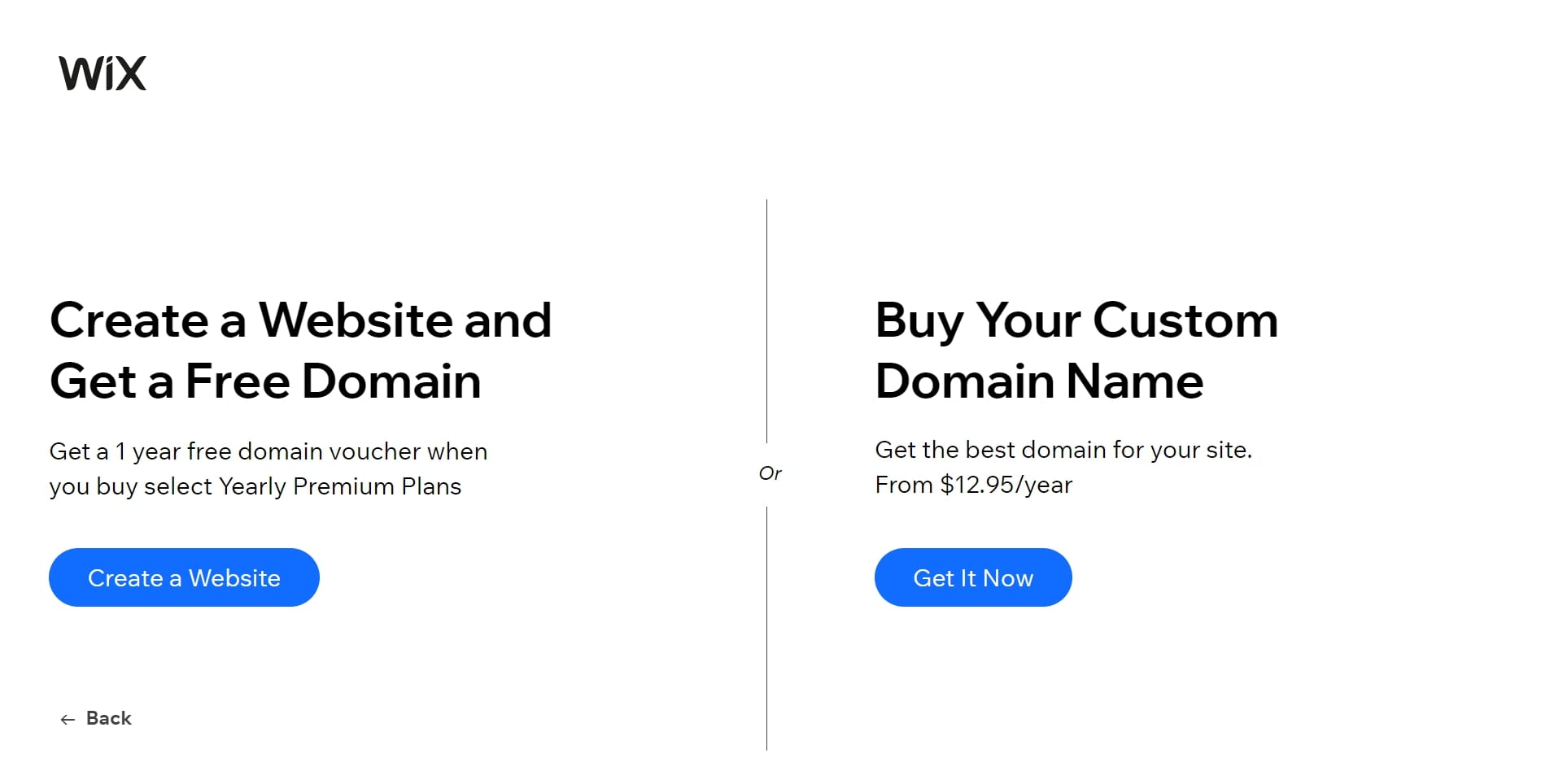
After finding a domain name you like, click Get It Now. The next step is to choose between getting a premium website builder plan or simply buying a domain name. The first option will make the domain registration fee free of charge.
For illustration purposes, we will go with the latter route by clicking Get It Now. At this stage, you will have to sign up for a Wix account.
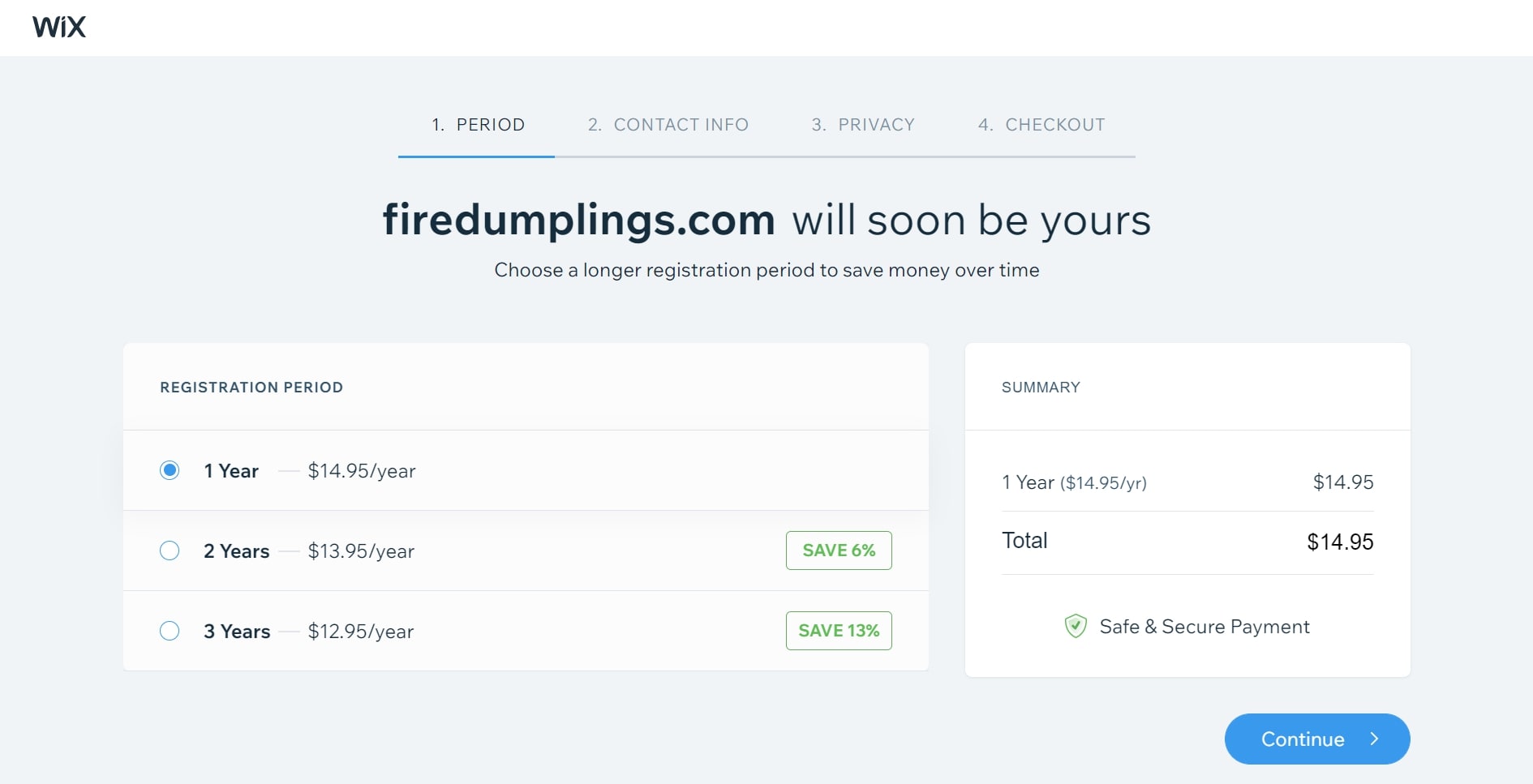
Now, pick whether to register the domain name for one, two, or three years. Wix offers a discount for longer registration periods.
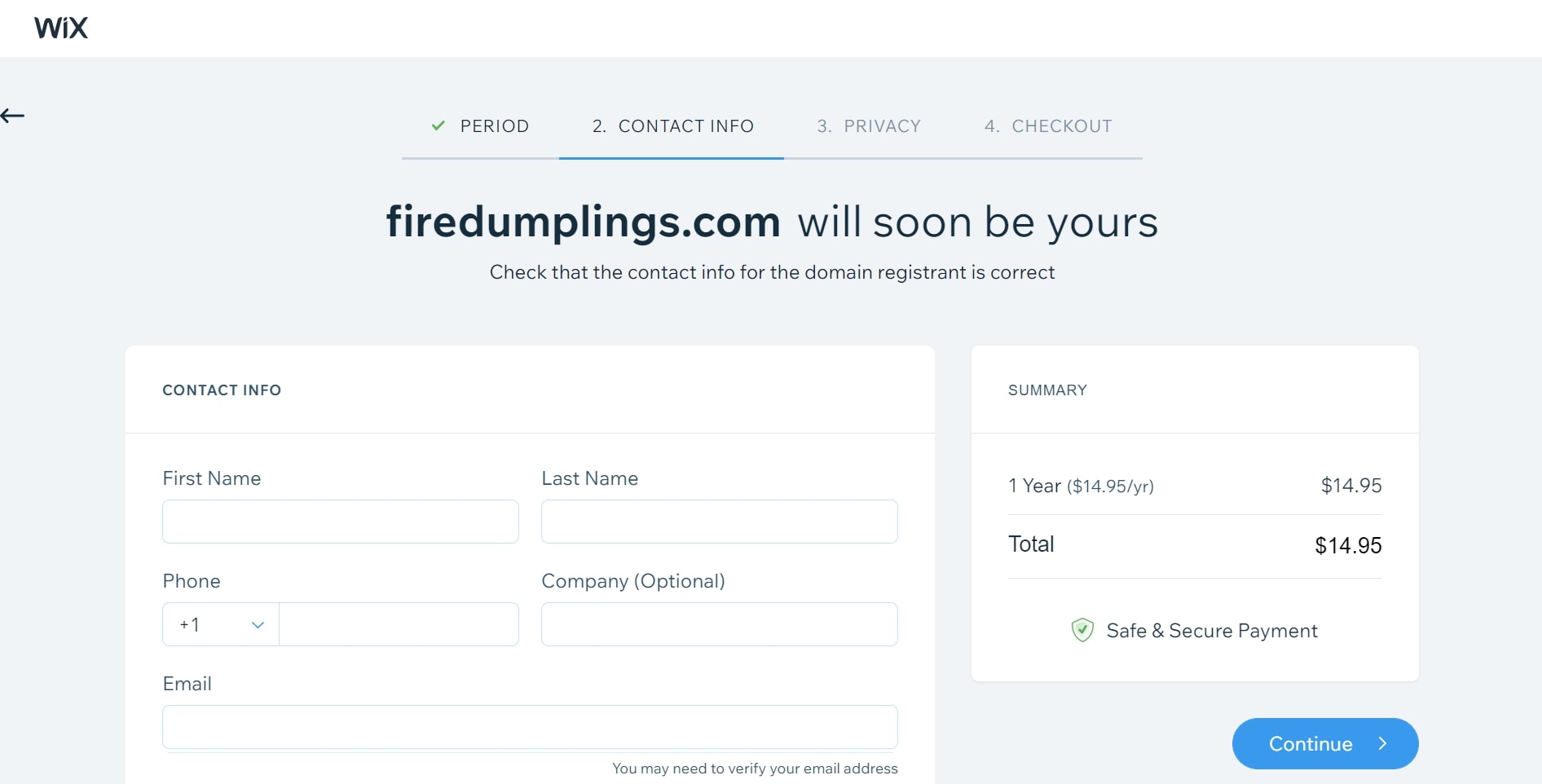
Then fill in the contact information, including your name, phone number, email, address, and postal code.
If you’re going to manage the domain and handle any tech-related issues it encounters, check the Tech Contact Info and Admin Contact Info boxes below. Otherwise, fill in the fields with the relevant contact details.
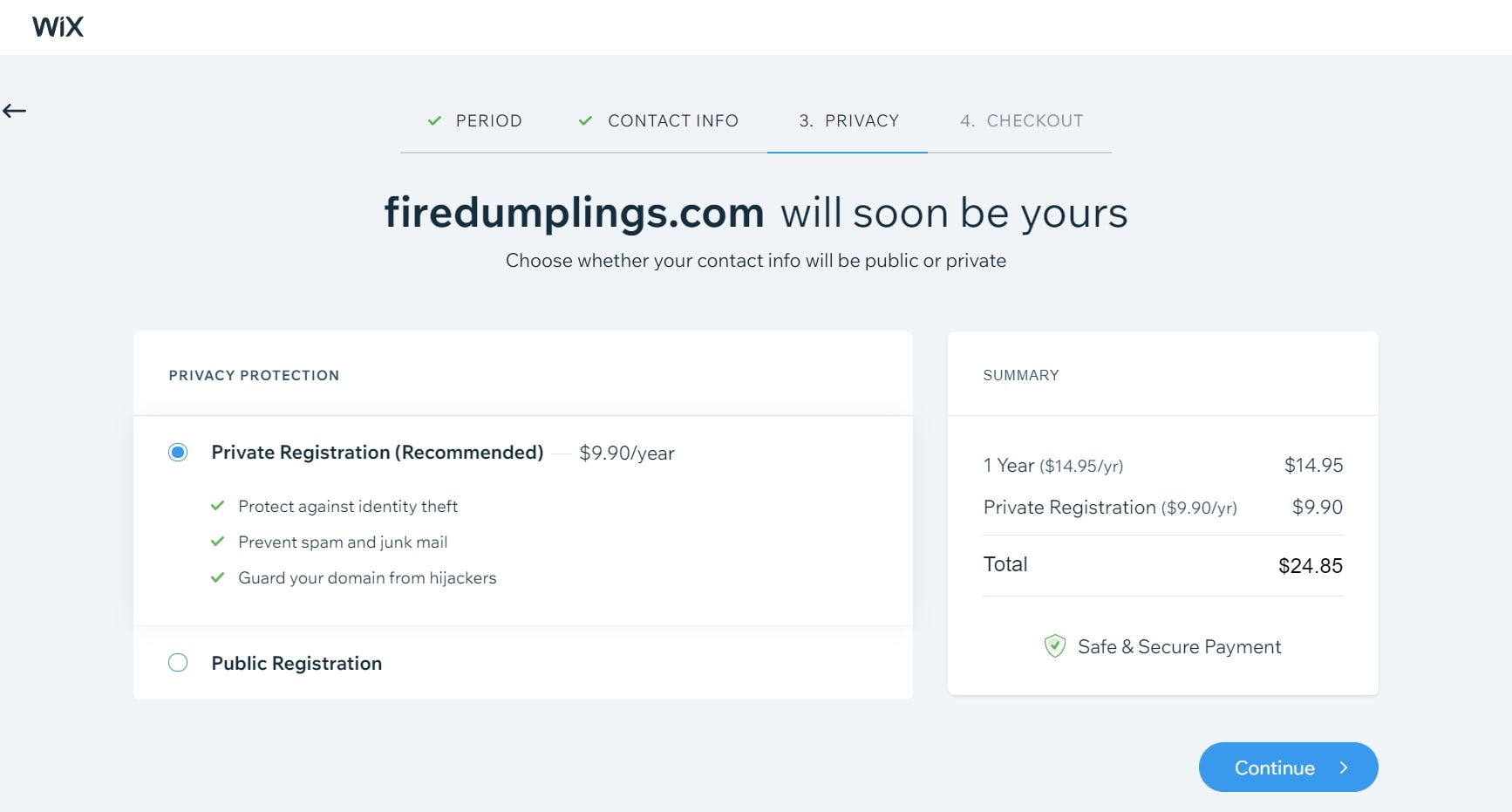
Lastly, enter your credit card information and invoice details to finalize the purchase. Check your registered email address inbox, as Wix will send a message to confirm the domain’s contact details.
How to register a domain name with GoDaddy
With over 20 million customers, GoDaddy is both a domain registrar and web hosting powerhouse. It has a wide array of domain extensions ranging from .com and .org to newer selections like .fun or .law. The company plans to add even more TLDs to its collection in the future.
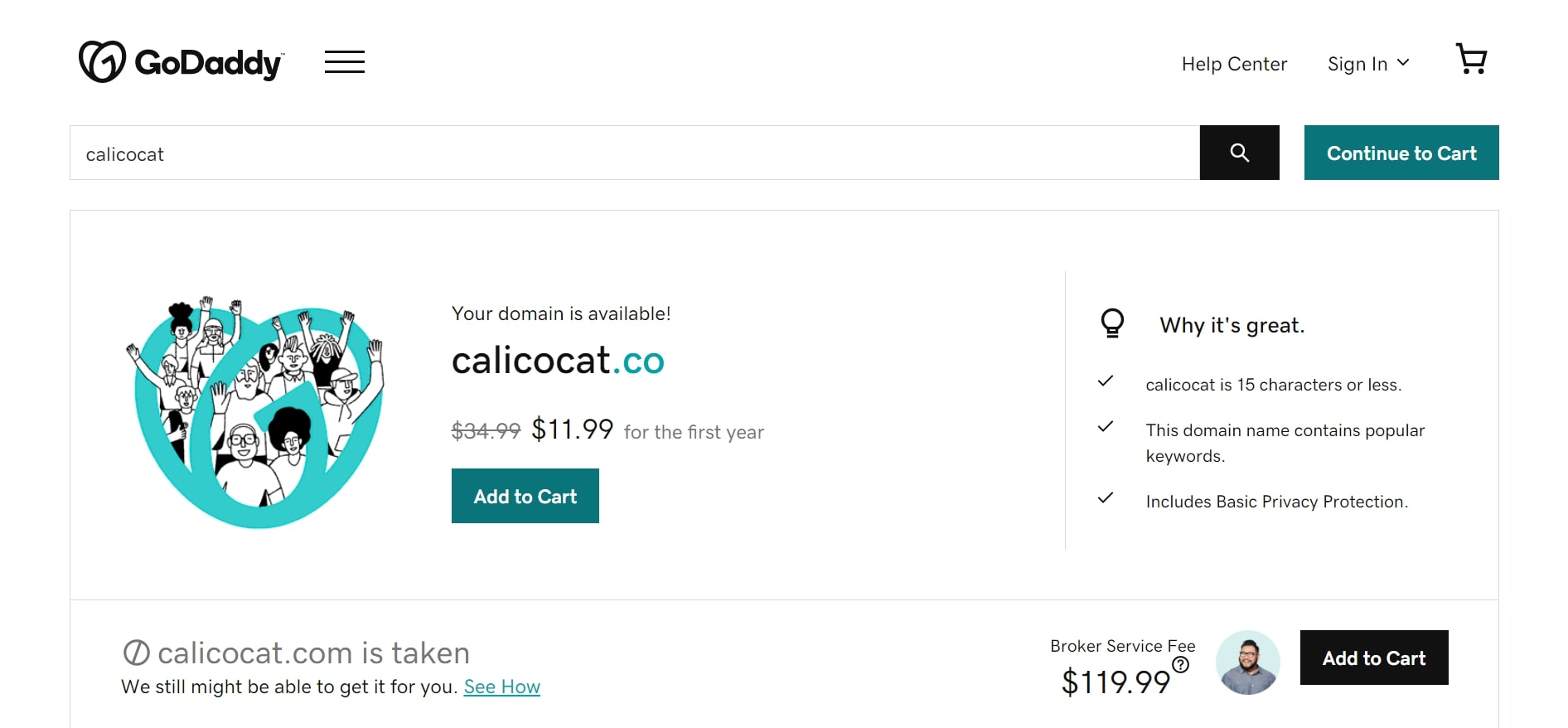
To buy a domain on GoDaddy, start with a domain name search on their homepage. The system will reveal whether the name is available for purchase using your desired extension.
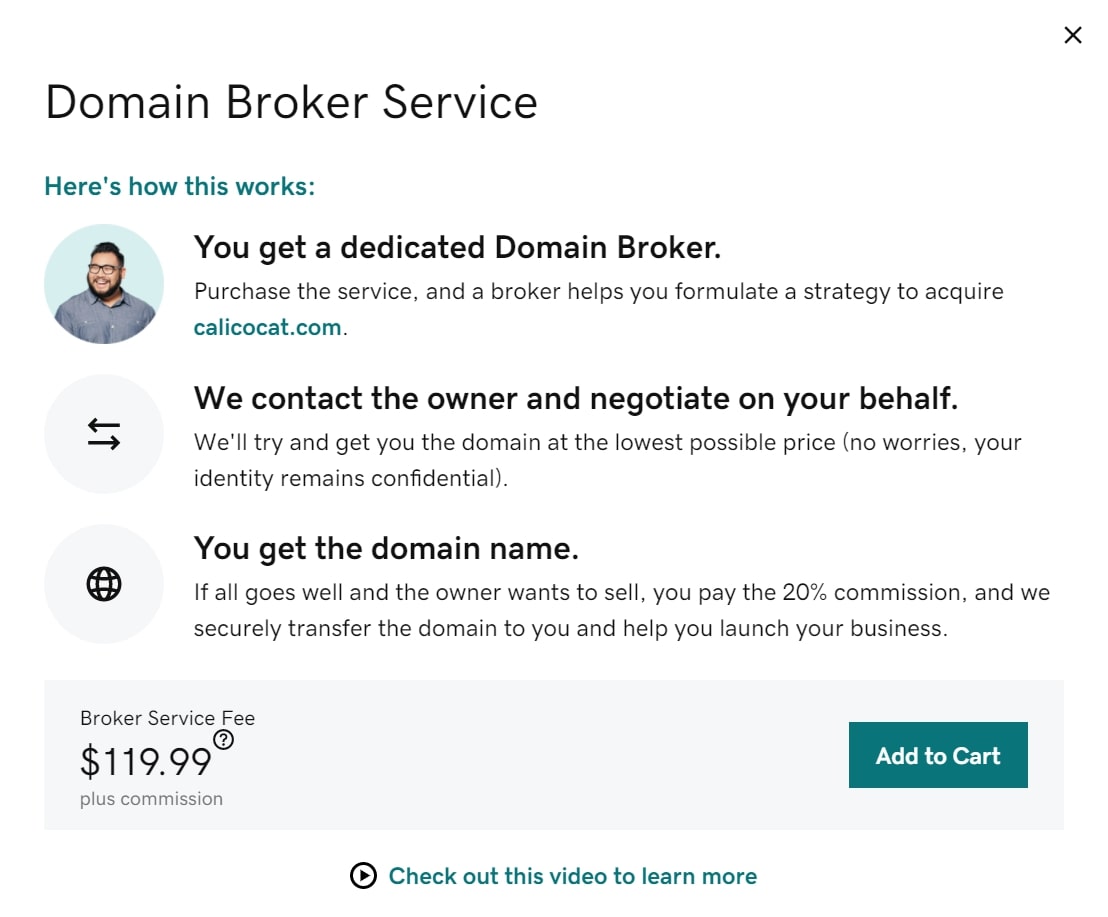
If the .com version is taken, GoDaddy offers a domain broker service, where a representative will negotiate with the owner to purchase the name for you. You will pay $119.99 and a 20% commission to hire the agent in addition to the domain registration fee.
Click Add to Cart on a domain name and continue to checkout. On the next page, GoDaddy will offer several add-ons to bundle the order with.
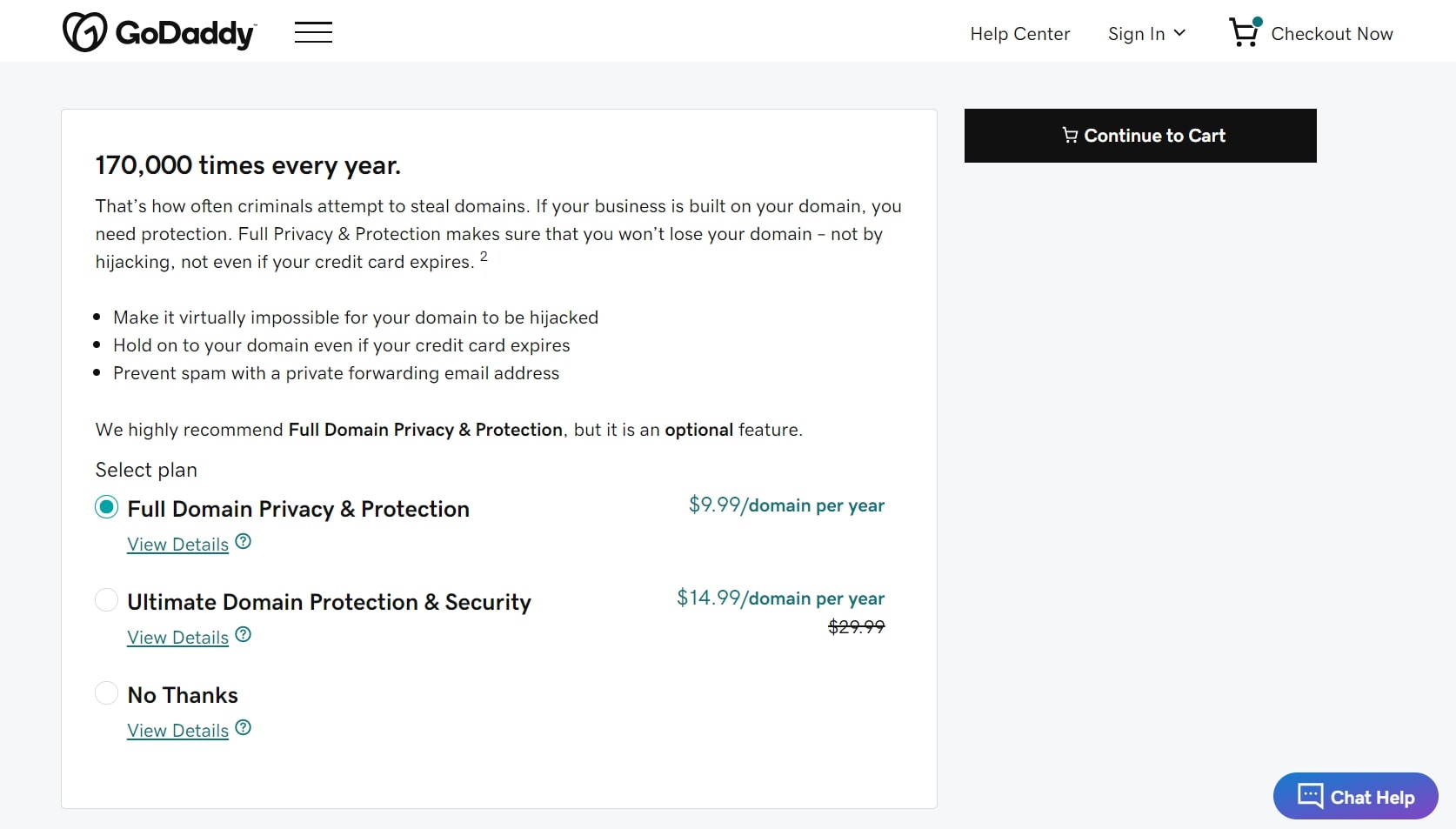
As an added bonus GoDaddy includes free privacy protection forever. This can protect you from bad actors trying to steal your information for illicit gains.
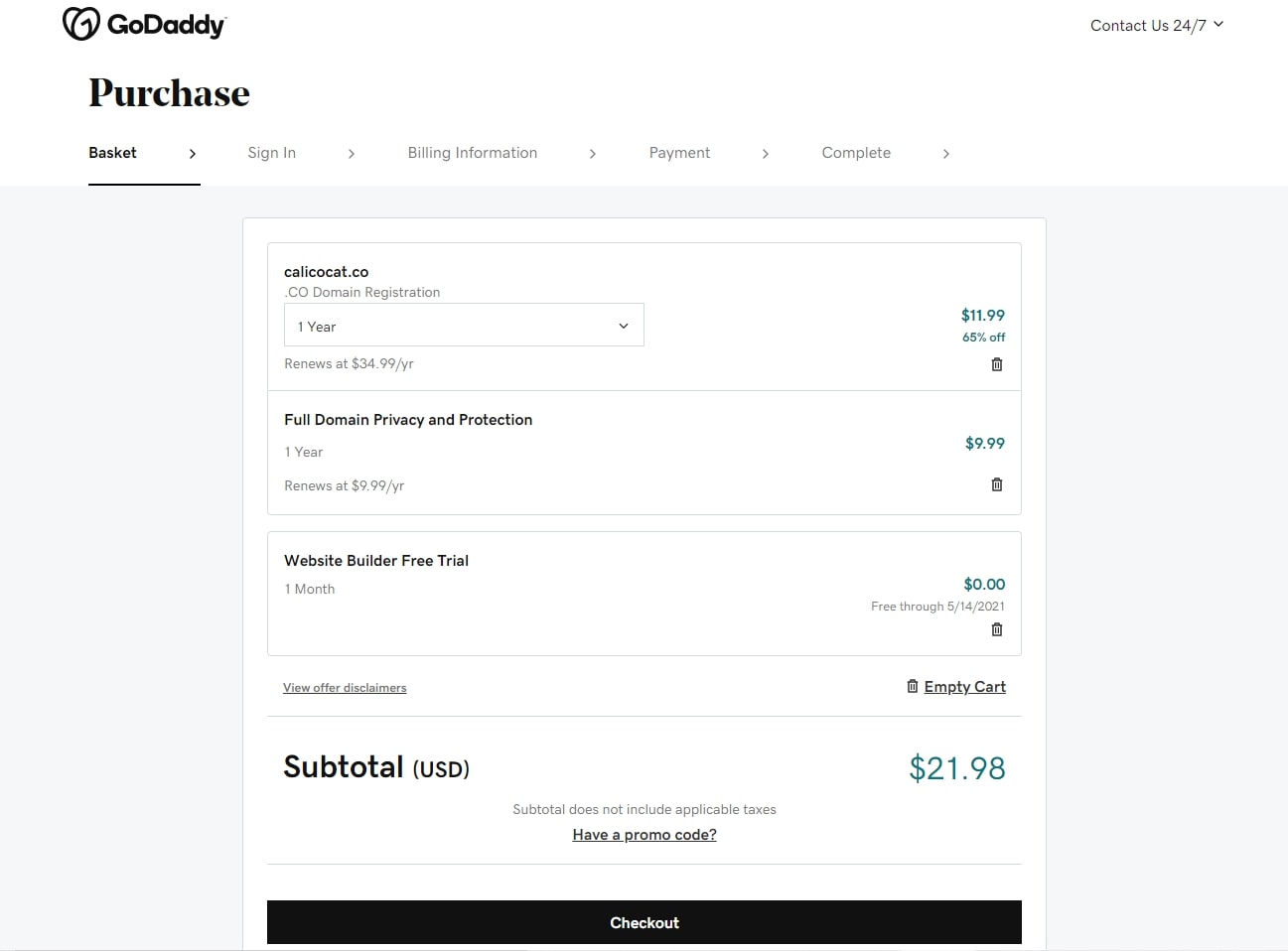
Choose any of the extras and press the Continue to Cart button. Then, a review of the purchase will appear, which also includes a free trial to GoDaddy’s website builder for one month. It’s also possible to change the registration period to up to five years.
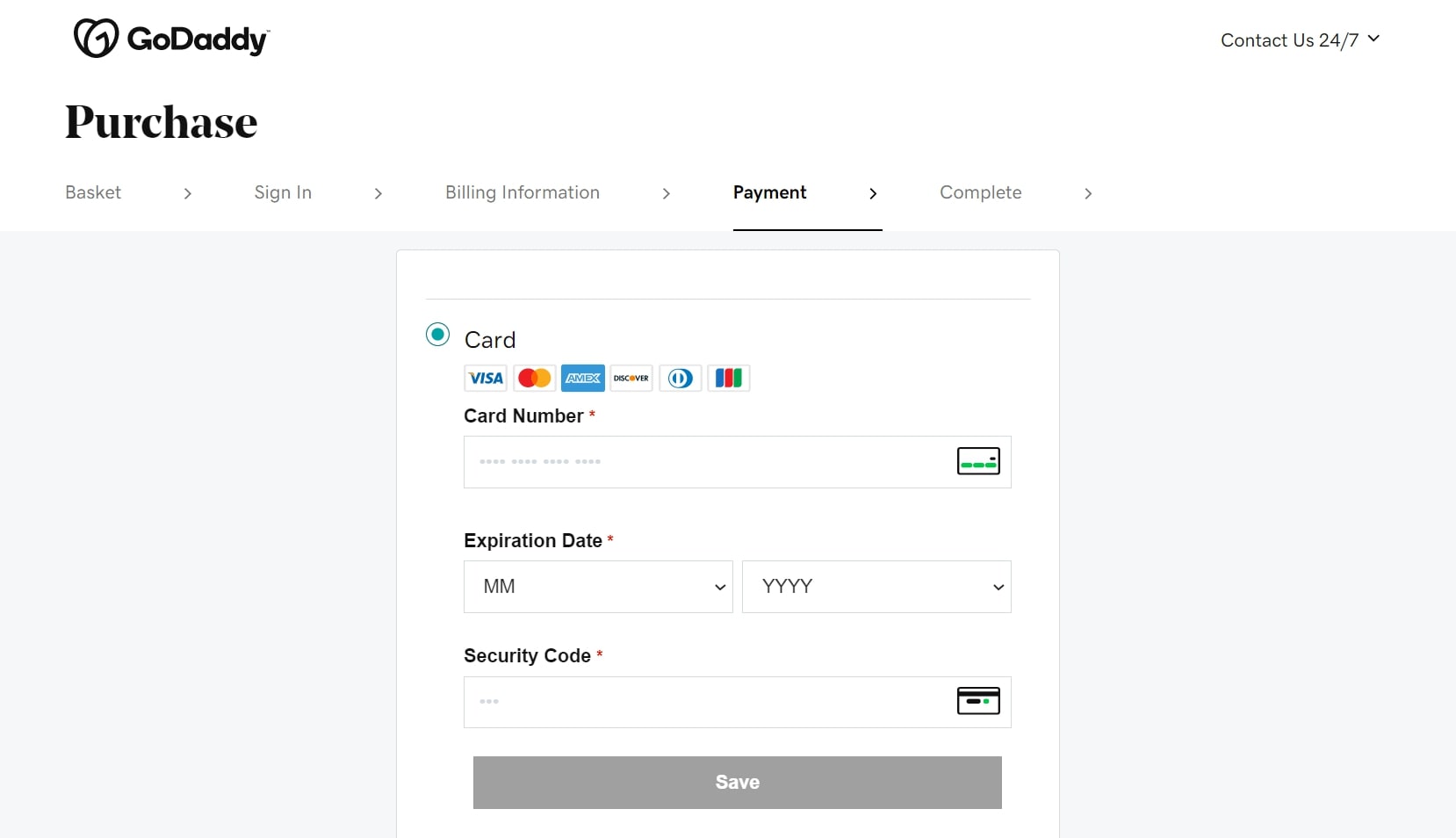
The next step is to create a GoDaddy account and fill in the billing information. There are three payment methods available – credit card, PayPal, and check.
After completing the payment process, the domain name is yours. As with previous domain registrars and web hosts, GoDaddy will send an email with a link to validate the domain ownership.
How to register a domain name with Namecheap
As the name suggests, this Namecheap offers great value for money. Its .com domains start from $16.98/year (but new customers can get one for $6.49), which is a low price compared to the rest of the market.
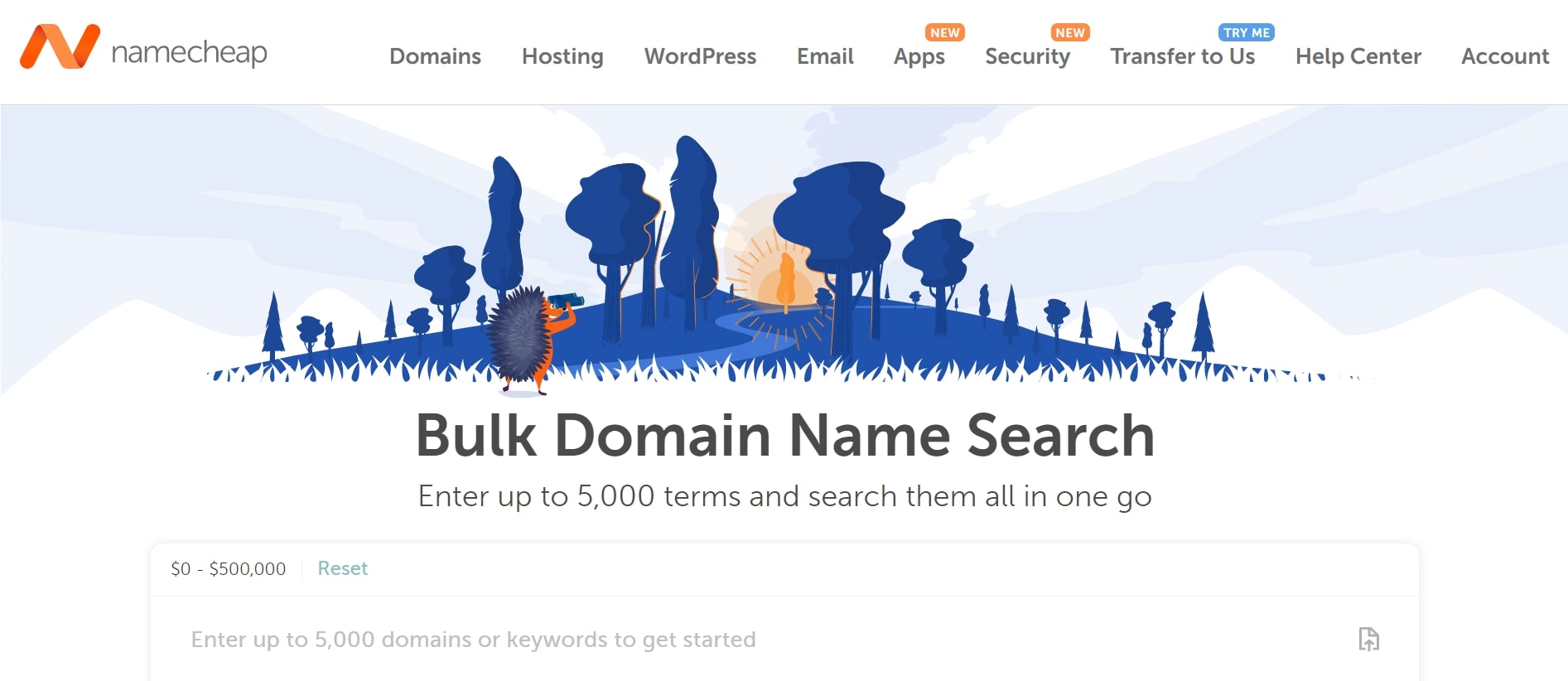
To buy a domain name on Namecheap, head over to the homepage and insert a name on the search field. Alternatively, head to the Bulk Domain Name Search tool and enter up to 5,000 keywords and find multiple domains at once.
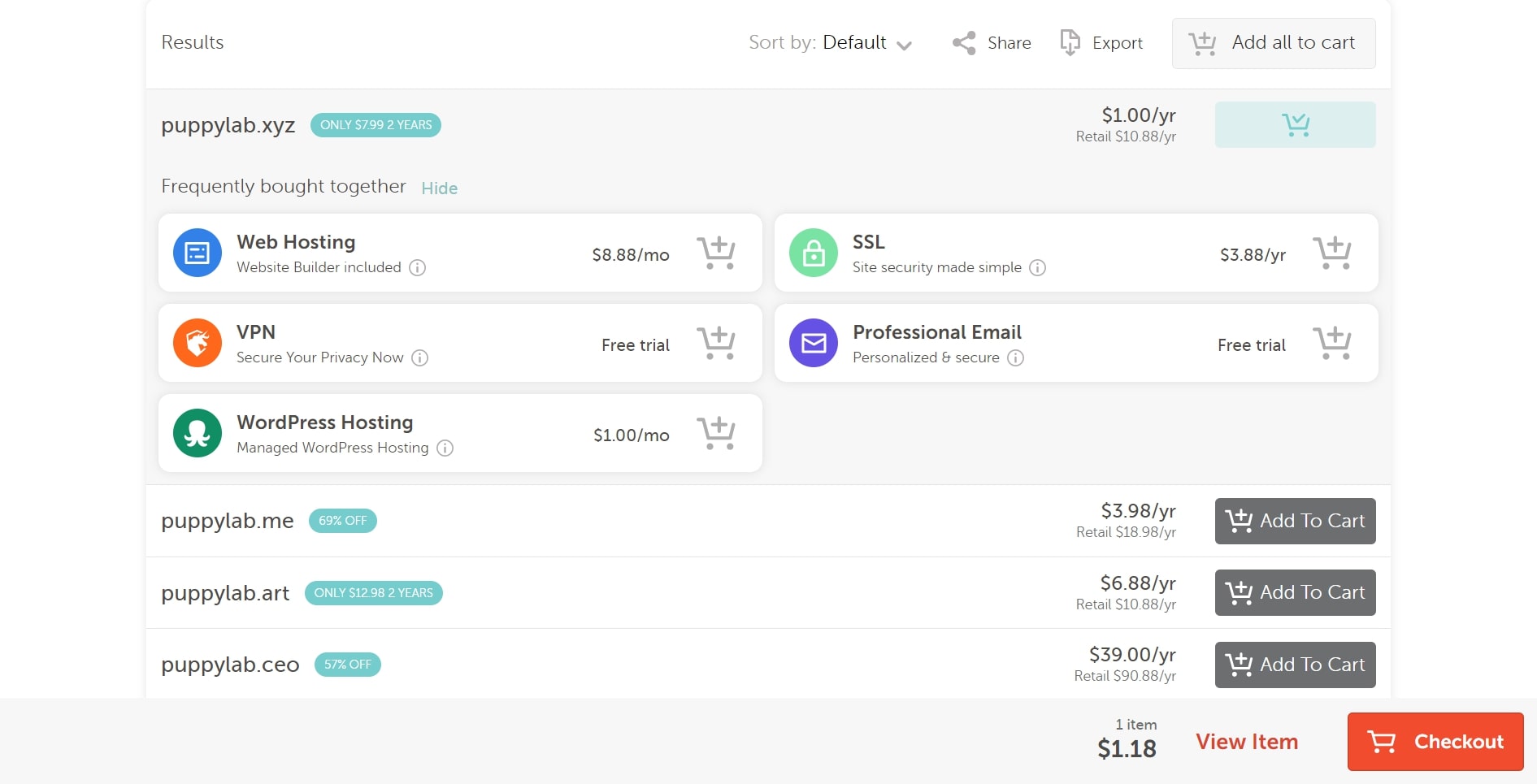
The site will redirect you to the search results page. Feel free to sort the available domains by cost, extension, or alphabetical order. Click Add to Cart on the name you want to register and the Checkout button on the bottom-right corner to continue with the payment process.
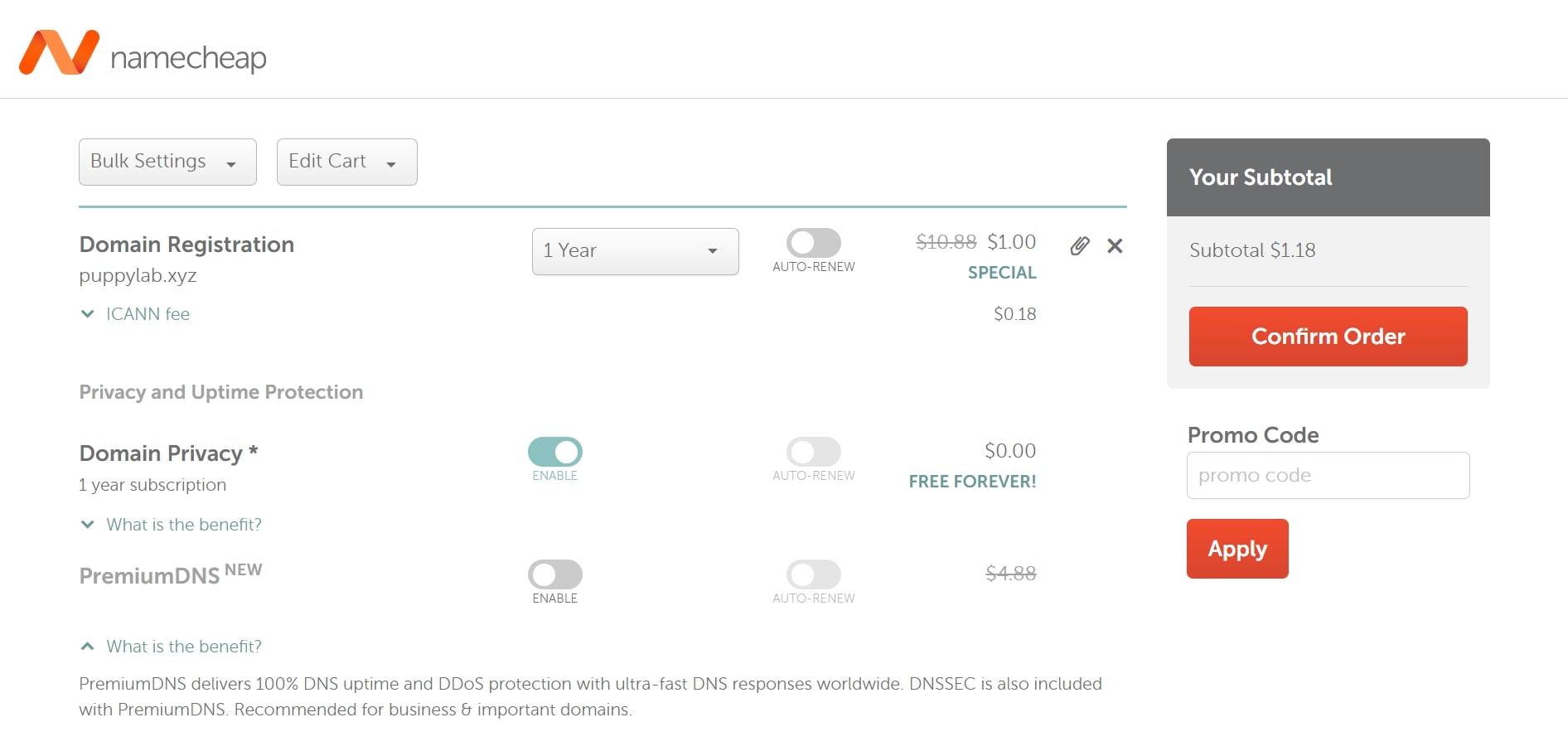
The page will preview the order and suggest several add-ons to add to the cart, including PremiumDNS for a performance and security boost. This domain registrar also provides a free privacy and protection feature.
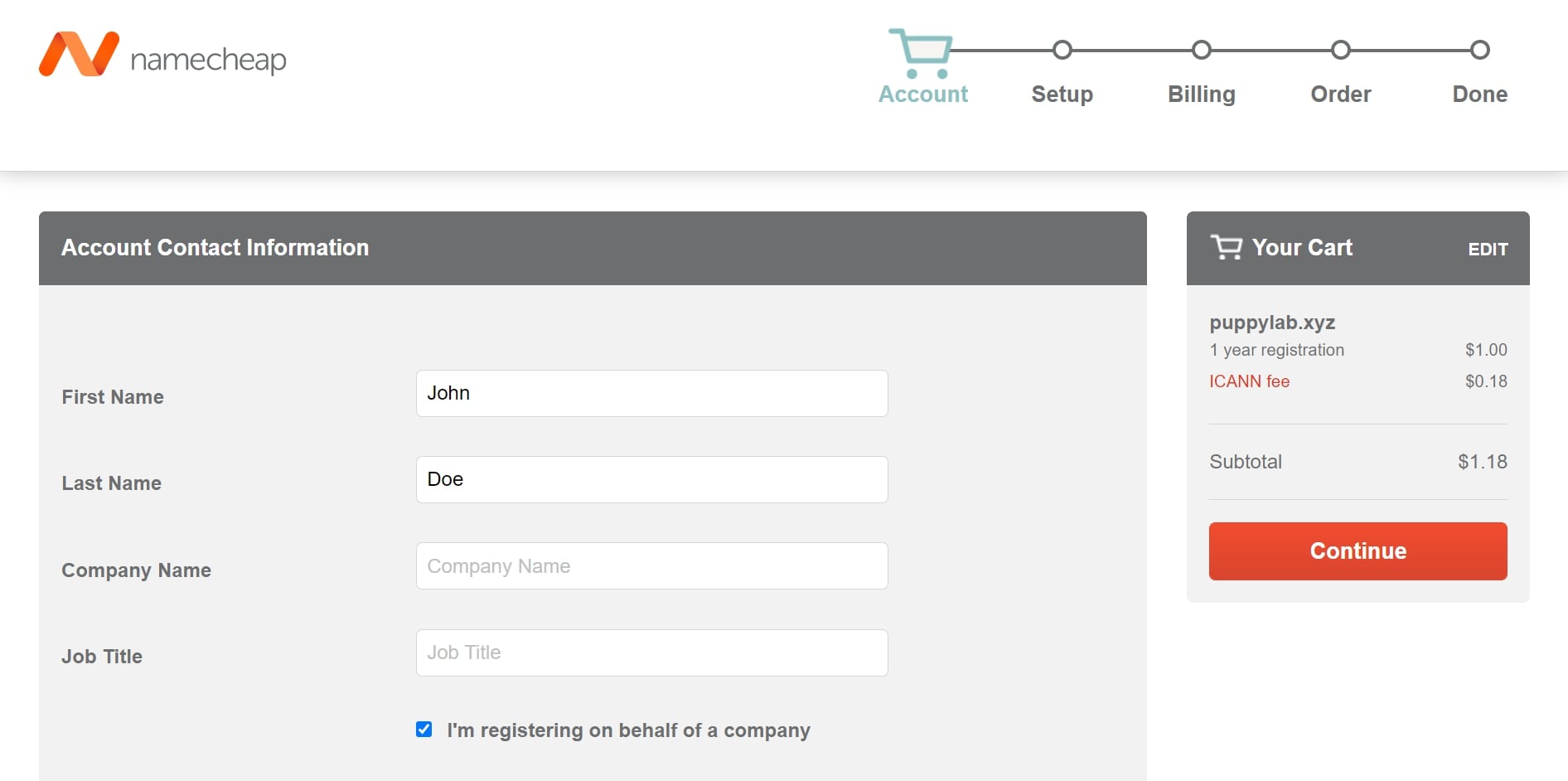
Confirm the order to move on to the next step – creating a Namecheap account. Insert your contact information, including your name, phone number, email, and physical address. Enter a company name and tick the I’m registering on behalf of a company box if applicable.
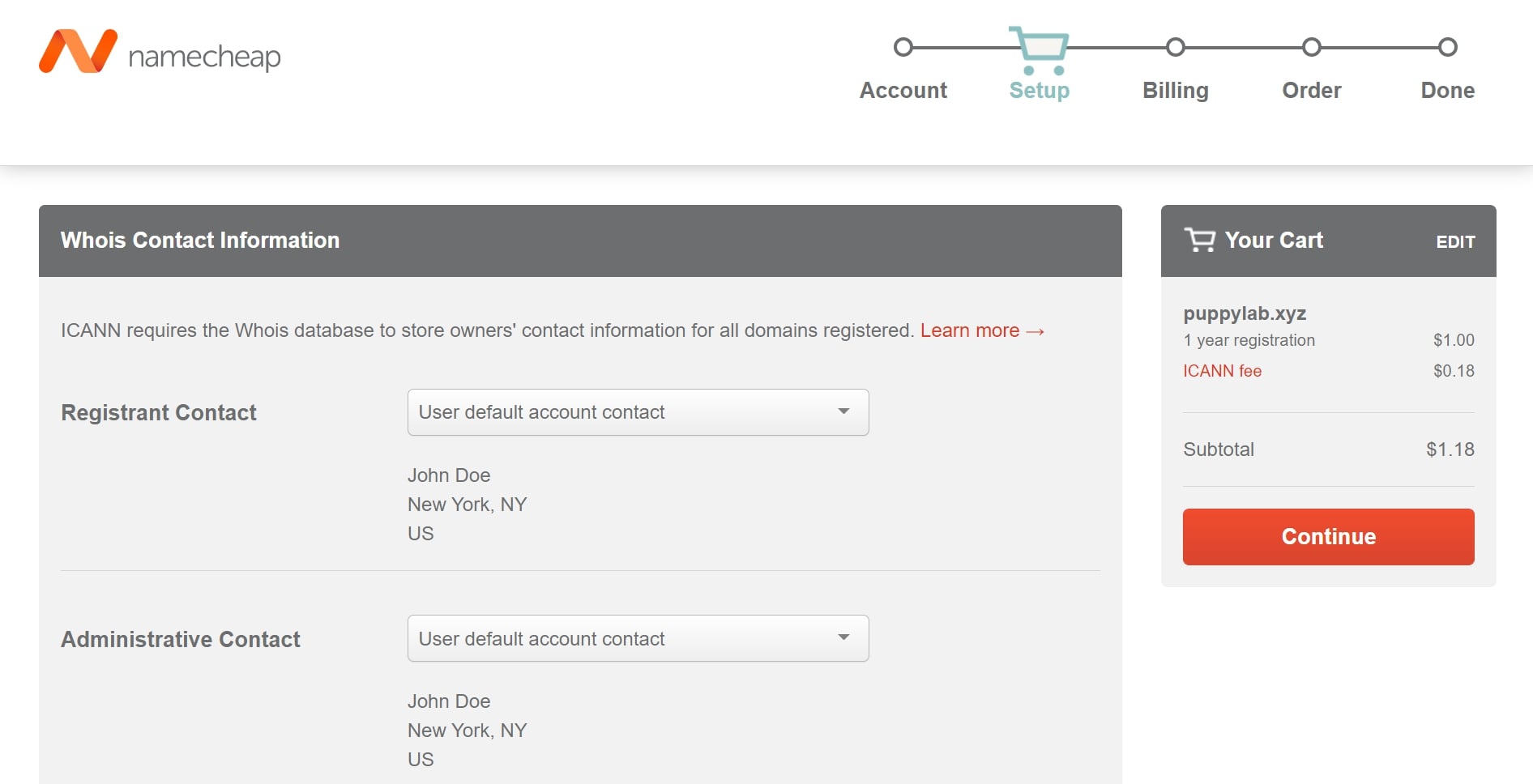
Press Continue to go to the Setup page. Here, specify the contact information for the domain’s registrant, administrator, technical support, and billings. If you’re responsible for all these things, select User default account contact. Otherwise, choose to Add new contact where appropriate.
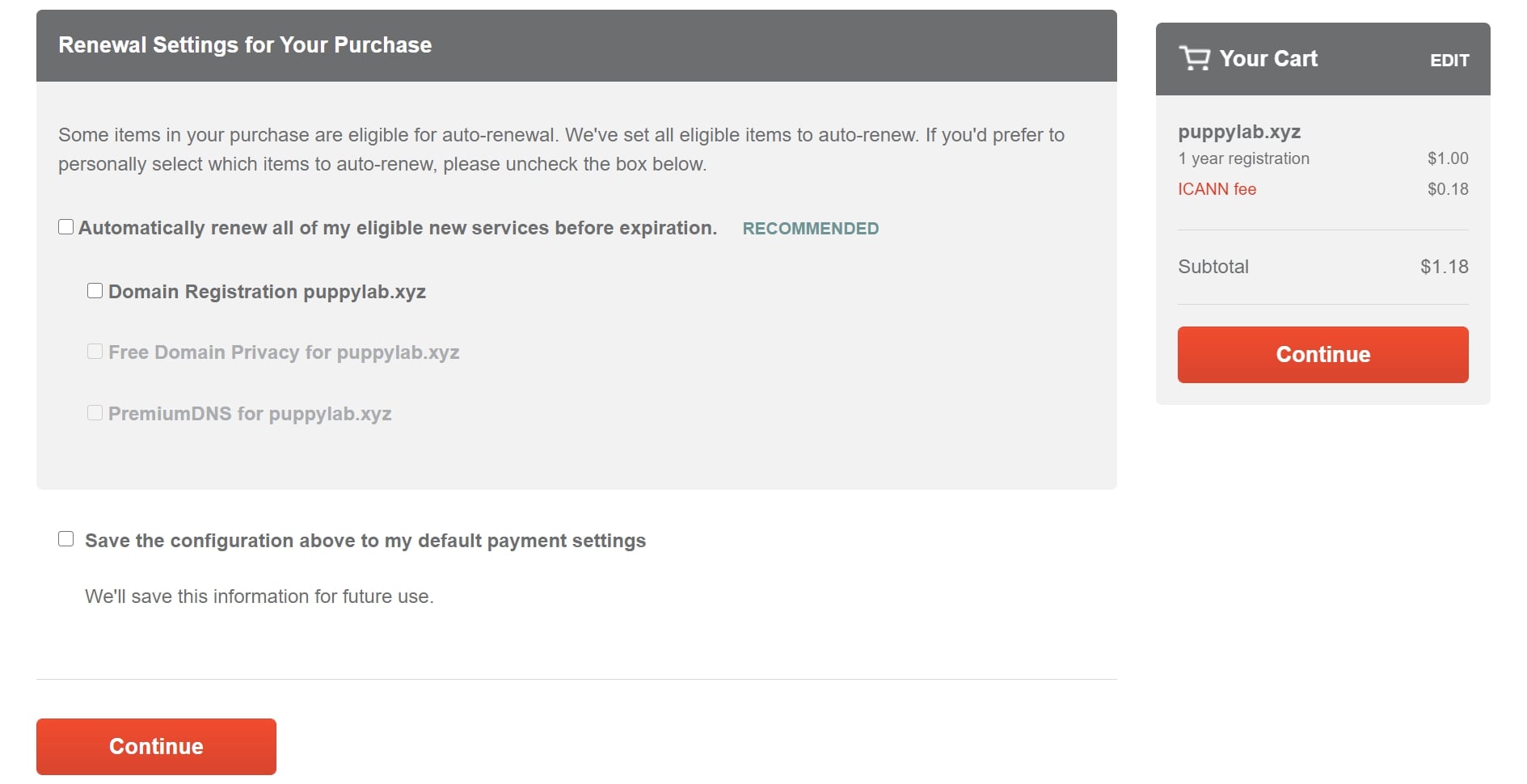
Click Continue to complete the payment process. Choose between using a credit card, PayPal, or Namecheap Account Funds. Also, feel free to enable automatic renewal for the domain registration.
Finally, review the order and finalize the payment. Once finished, check for a verification email in your inbox and click on the link to validate the domain ownership.
Tips when registering a domain name
Obtaining the right domain name from the start is important, especially if you’re creating a business or personal brand website. Changing domains is not only expensive but also potentially damages search engine rankings and conversion rates.
With this in mind, here are some things to consider when buying a domain name:
- If the domain name is unavailable, use a name generator. Namelix is an excellent example of this. Insert the business name or website name, then choose a naming length and style. The tool will come up with some ideas based on your criteria.
- Avoid hyphens and numbers. They can make the domain name difficult to share via word-of-mouth.
- Include rhyme, rhythm, or alliteration. These poetic devices can make the domain name easier to remember.
- Check the trademark database. Steer clear from domain names that sound too similar to existing brands to avoid getting into legal trouble.
- Check for corresponding social media handles. To make your brand’s online presence easier to discover, it’s best to use the same name for all of your social profiles.
- If possible, buy the misspelled variations of the domain name. That way, you won’t miss out on any potential traffic. For instance, Google owns gogle.com so that people who mistype their URL can use the search engine immediately.
- Think long-term. Make sure the domain name can support your brand now and in the future. Avoid trending terms to leave room for growth.
- Choose a reliable domain registrar. Check their terms of service and reputation before making the purchase. If you’re new to domain name registration, it helps to pick a company with a responsive support team.
Conclusion
We’ve shown you how to buy a domain name with different registrars and web hosting providers – from Hostinger, HostGator, to Domain.com. No matter which vendor you choose, make sure it offers the best service for your money.
Domain names are a long-term investment, so take your time to brainstorm the perfect one for your website. Most importantly, the name should be concise, catchy, and relevant to your business so that it remains top-of-mind for your target audience.
With the tips and tutorials explained above, you should be on your way to getting a great domain name. Best of luck.
- We've also featured the best website builder

Désiré has been musing and writing about technology during a career spanning four decades. He dabbled in website builders and web hosting when DHTML and frames were in vogue and started narrating about the impact of technology on society just before the start of the Y2K hysteria at the turn of the last millennium.
- James CapellB2B Editor, Web Hosting
You must confirm your public display name before commenting
Please logout and then login again, you will then be prompted to enter your display name.